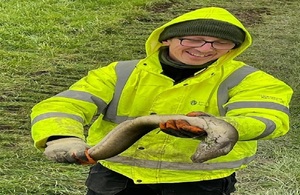Working ‘eel-y’ hard this winter to keep Kent rivers flowing
Winter flood maintenance encourages wildlife and biodiversity into rivers and streams. Widespread eels important indicator of healthy waterways

Eel do! One of the larger species cared for by an Environment Agency officer during river maintenance work
The Environment Agency has been working hard this winter along the Great Stour, East Stour and Wingham rivers to help improve flows. Teams have been clearing rivers, streams, trash screens and culverts, and removing fallen and trees and blockages as part of their winter-ready work to help prevent flooding.
A major part of the Environment Agency’s winter maintenance work is desilting. This process involves scraping and removing soft mud that has settled on the bottom of a riverbed over a period of years. This is done to improve the flow of water and prevent blockages, which can help prevent flooding, as it allows rivers to run as they should – at full capacity.
Environment Agency teams use 45-tonne long-reach excavators with a 20-metre reach arm to desilt the riverbed, allowing the operator to sit back from the river edge and still be able to see the watercourse.

The Environment Agency uses huge excavators to ultimately protect Kent communities from flooding
The amount of silt removed per river can be from one to six tonnes per three metres of river, depending on the river size and how long the process is done.
Annually, more than 1,000 tonnes of silt is removed across south-east Kent – the weight of a cargo ship! Once the excavated silt is scraped from the riverbed, it is first deposited on the bankside, where it is carefully inspected for any fish, eels or other species that could have been caught up in the process.
Any aquatic life that is found is safely returned to the watercourse once work is completed. This fertile mud is then put to good use and is relocated back onto farmers’ fields.
Eels, a protected species, are frequently found when desilting. These are always returned to the river or stream where they came from. The largest eel recently found in the North Stream in Sandwich was two feet long, or half a metre! Eels are an important indicator of the health of our waterways and freshwater habitats.
Debbie Thompson, east Kent field team leader from the Environment Agency, said:
I really enjoy the job that I do and working alongside my colleagues in the field team, including seeing them operating the heavy plant and machinery they use to do their work.
I love spending time in the environment when out managing the watercourses and knowing that I am helping protect properties from flood-risk.
A great benefit of my work is seeing the many wonderful animals and plants during the day, such as beavers, birds, fish and eels, and improving habitats.
When desilting, there is always a 500-metre gap left between sections. The gaps help maintain the existing wildlife habitat and encourages biodiversity. It also allows silt species to move along the river. Eventually, the gaps fill in with the silt left behind, and the ground silt animals continue to thrive along the whole riverbed.

The River Wingham, near Canterbury, before desilting...

...and after, improving the flow and biodiversity, and helping protect local homes and businesses from flooding
Desilting in Kent is just one part of the work the Environment Agency has carried out to protect local communities from flooding over the winter months. Environment Agency teams are on duty throughout the year, checking that all flood-protection structures are fully functional, and they continue to monitor and clear weed screens and blockages.
An array of different and unusual things are sometimes found when clearing watercourses, including old mattresses and shopping trolleys, as well as the usual fallen trees – anything that will stop or hinder the flow, ahead of adverse winter weather.
Rivers are silt-tested regularly. Specialist teams monitor the build-up of silt over many years, and they plan for a five-year desilt silt programme.
See a selection of photos here: https://we.tl/t-SydoRpdD8S, or contact the Environment Agency press office at [email protected] photos include one of a very large eel found, the equipment used to desilt rivers, and before and after desilting. Please credit the Environment Agency.
Read more about the work that Debbie Thompson and her east Kent field team does, in our blog: Helping to keep rivers flowing but not flooding - Creating a better place (blog.gov.uk).